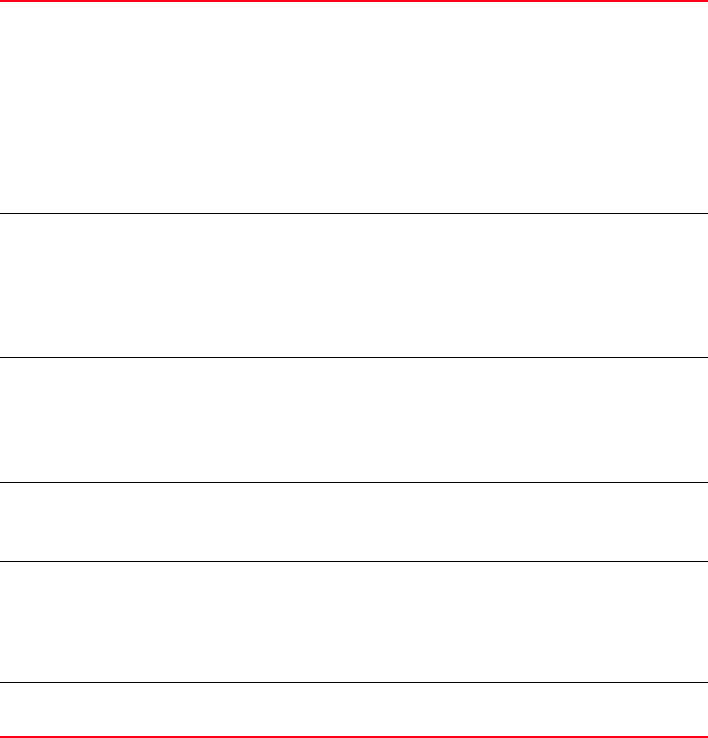Network Router User Manual
Table Of Contents
- About This Document
- Introduction
- Common Commands
- In this chapter
- Common commands
- show
- autoinstall
- banner
- commands
- crypto
- environment
- history
- interfaces
- ip
- ldap
- licenses
- logging
- mac
- mac-address-table
- management
- mobility
- ntp
- port-channel
- power
- privilege
- radius
- redundancy dynamic-ap-load-balance
- redundancy group
- redundancy history
- redundancy members
- rtls
- smtp-notification
- snmp
- snmp-server
- spanning-tree
- static-channel-group
- terminal
- timezone
- traffic-shape
- users
- version
- wireless
- (config-wireless) Executable Mode
- wlan-acl
- access-list
- aclstats
- alarm-log
- boot
- clock
- debugging
- dhcp
- file
- ftp
- password-encryption
- running-config
- securitymgr
- sessions
- startup-config
- upgrade-status
- mac-name
- firewall
- role
- virtual-IP
- wwan
- aap-wlan-acl
- aap-wlan-acl-stats
- protocol-list
- service-list
- User Exec Commands
- Privileged Exec Commands
- Global Configuration Commands
- In this chapter
- Global Configuration commands
- aaa
- access-list
- autoinstall
- banner
- boot
- bridge
- country-code
- crypto
- do
- end
- errdisable
- ftp
- hostname
- interface
- ip
- license
- line
- local
- logging
- mac
- mac-address-table
- mac-name
- management
- ntp
- prompt
- radius-server
- ratelimit
- redundancy
- role
- rtls
- service
- smtp-notification
- snmp-server
- spanning-tree
- timezone
- traffic-shape
- username
- vpn
- wireless
- wlan-acl
- network-element-id
- firewall
- virtual-ip
- wwan
- aap-wlan-acl
- arp
- power
- aap-ipfilter-list
- whitelist
- Crypto-isakmp Instance
- Crypto-group Instance
- Crypto-peer Instance
- Crypto-ipsec Instance
- Crypto-map Instance
- Crypto-trustpoint Instance
- Interface Instance
- Spanning tree-mst Instance
- Extended ACL Instance
- Standard ACL Instance
- Extended MAC ACL Instance
- DHCP Server Instance
- DHCP Class Instance
- Radius Server Instance
- Wireless Instance
- In this chapter
- Wireless configuration commands
- aap
- admission-control
- adopt-unconf-radio
- adoption-pref-id
- ap
- ap-containment
- ap-detection
- ap-image
- ap-ip
- ap-standby-attempts-threshold
- ap-timeout
- ap-udp-port
- auto-select-channels
- broadcast-tx-speed
- client
- clrscr
- cluster-master-support
- convert-ap
- country-code
- debug
- dhcp-one-portal-forward
- dhcp-sniff-state
- dot11-shared-key-auth
- end
- exit
- fix-broadcast-dhcp-rsp
- help
- hotspot
- load-balance
- mac-auth-local
- manual-wlan-mapping
- wireless-client
- mobility
- multicast-packet-limit
- multicast-throttle-watermark
- nas-id
- nas-port-id
- no
- proxy-arp
- qos-mapping
- radio
- rate-limit
- secure-wispe-default-secret
- self-heal
- sensor
- service
- show
- smart-rf
- smart-scan-channels
- wlan
- wlan-bw-allocation
- dot11k
- wips
- non-preferred-ap-attempts-threshold
- test
- RTLS Instance
- ESPI Instance
- RFID Instance
- SOLE Instance
- Smart RF Instance
- Role Instance
- AAP IP Filtering

Brocade Mobility RFS4000, RFS6000 and RFS7000 CLI Reference Guide 413
53-1001931-01
Interface config commands
12
Parameters
Usage Guidelines
IPv4 commands are not allowed on a L2 interface. Use the
ip access-group command to attach
an access list to an interface. Use the
no ip access-group command to remove the access list
from the interface
Use
mac access-group to attach a MAC access list to an interface
Use the
{no} ip [options] command to undo IP based interface configurations
Example
RFController(config-if)#ip access-group 110 in
RFController(config-if)#
RFController(config-if)#ip address 192.168.234.1/24
RFController(config-if)#
access-group
[<1-99>|
<100-199>|
<1300-1999>|
<2000-2699>]
Defines the access group
• <1-99> – Sets the IP standard access list
• <100-199> – Sets the IP extended access list
• <1300-1999> – Sets the IP standard access list
(expanded range)
• <2000-2699> – Sets the IP extended access list
(expanded range)
• WORD in – Defines the access list name
• in – Sets incoming packets
ip address [ <IP Mask>
{secondary}|dhcp]
Sets a static IP address and network mask for a Layer 3 SVI
(Controller Virtual Interface)
• <IP/ Mask> {secondary} – Sets the IP address (10.0.0.1/8)
• secondary – Defines an optional secondary IP address
• dhcp – Uses a DHCP Client to obtain an IP address for the
interface (this enables DHCP on a Layer 3 SVI)
helper-address <IP> Forwards DHCP and BOOTP packets
• <IP> - Defines the IP to which DHCP and BOOTP packets
are forwarded
NOTE: IP helper addresses can only be applied on SVI but not
on the physical interfaces.
nat [inside|outside] Sets Network Address Translation (NAT) parameters
• inside – Inside interface
• outside – Outside interface
arp [rate-limit
<1-1000000>|
trust]
Sets arp for the packets
• rate-limit <1-1000000> – Displays the allowed rate in
packets per second
• trust – Displays trust state for arp responses coming in this
interface
dhcp trust Sets dhcp trust state for dhcp responses coming in this
interface










